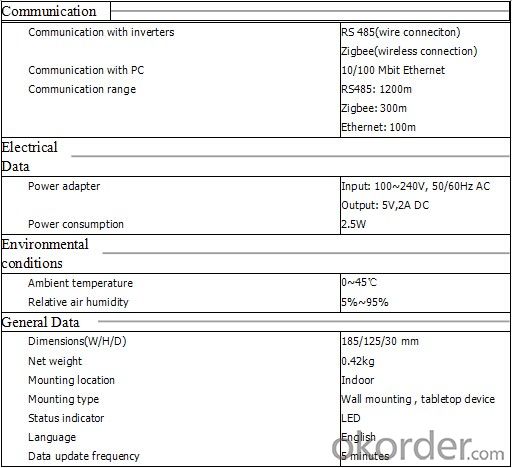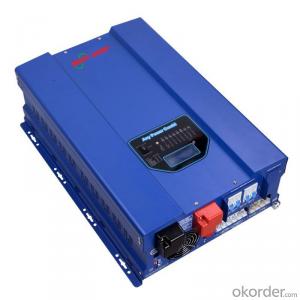Solar Inverter Replacement Brisbane - Shine Wi-Fi, Solar System Monitoring, Remote Control
- Loading Port:
- Shekou
- Payment Terms:
- TT OR LC
- Min Order Qty:
- 100 watt
- Supply Capability:
- 1000000 watt/month
OKorder Service Pledge
OKorder Financial Service
You Might Also Like
Shine Wi-Fi, Solar System Monitoring, WIFI
Professional monitor through Internet and environment
100-meter wireless connection to inverter
Easy-to use
Every inverter installed with Wi-Fi can be monitored in your own project
Remote setting and updating
Cost-effective


FAQ
Is solar power difficult to use?
Although the production of solar panels incorporates a high-tech manufacturing process, it is really very easy to use a photovoltaic system. Solar panels have no moving parts to wear out, they can be used alone or in combination with other energy sources, and they are silent, reliable and long lasting.
What can you power with Photovoltaics?
A properly designed photovoltaic system can supply electricity for many applications, from small remote lighting needs to megawatts of power for large utility companies. An advantage of photovoltaic power is that it can do anything a traditional power generator can do, only without consuming pollution-causing fuel, or requiring noisy motors.
What is a PV system?
A PV system consists of all the equipment and materials needed to generate solar energy, including solar panels (often called modules), a support structure, wiring, an inverter, a meter and other equipment as required by a specific application. JUST-SOLAR's PV system for commercial buildings, and ET Solar system for residential uses are examples of complete PV systems.
What is a solar module?
Solar modules are series of solar cells, wired together and enclosed protect them from the environment. They are often referred to as in self-contained glass units to solar panels as well.
How do solar cells work?
Solar cells are solid-state devices in which photons (or packets of light) collide with atoms. This process transforms the resulting into electrons. These electrons flow into wires connected to the cell, thus providing electric current to appliances, lighting systems or other electrical loads; and all of the power comes directly from the sun.
What is Photovoltaic Power?
Photovoltaic (PV) power is a term used to describe the process of converting sunlight into electricity with solar cells. These cells are specially constructed from semiconductor materials, and are treated to generate a flow of electricity when sunlight shines on them
- Q: What is the maximum number of MPPT inputs in a solar inverter?
- The maximum number of MPPT (Maximum Power Point Tracking) inputs in a solar inverter can vary depending on the specific model and brand. However, some larger and more advanced solar inverters can have up to 12 or more MPPT inputs, allowing for greater flexibility and optimization in harnessing solar power from multiple arrays or orientations.
- Q: Can a solar inverter be used in a mobile or RV application?
- Yes, a solar inverter can be used in a mobile or RV application. It allows the conversion of direct current (DC) from solar panels into alternating current (AC) that can be used to power appliances, devices, and other electrical equipment inside the mobile or RV. This enables the vehicle to utilize solar energy for various power needs while on the move.
- Q: How does the power factor affect the performance of a solar inverter?
- The power factor affects the performance of a solar inverter by influencing its efficiency and capacity to convert DC power from solar panels into AC power. A low power factor can result in increased losses and reduced efficiency, leading to lower overall performance. On the other hand, a high power factor ensures efficient power conversion, minimizing losses, and optimizing the inverter's performance.
- Q: Can a solar inverter be used with concentrated solar power systems?
- Yes, a solar inverter can be used with concentrated solar power systems. Concentrated solar power systems use mirrors or lenses to concentrate sunlight onto a receiver, which then converts the solar energy into heat or electricity. This generated electricity needs to be converted from direct current (DC) to alternating current (AC) for use in the electrical grid or to power appliances. A solar inverter performs this function by converting the DC output of the concentrated solar power system into AC power.
- Q: After the PV inverter, how to achieve the same period before the network?
- It can automatically detect the generator and the grid frequency and voltage, in the frequency, voltage, phase are in line with the requirements of the grid to set the time before the release of the closing signal, so that it can be safely and securely connected.
- Q: Can a solar inverter be used in regions with high levels of electromagnetic interference?
- Yes, a solar inverter can be used in regions with high levels of electromagnetic interference. However, it is important to ensure that the inverter is properly shielded and meets the necessary electromagnetic compatibility standards to minimize any potential disruptions or malfunctions caused by the interference.
- Q: How do you calculate the maximum power point tracking range for a solar inverter?
- To calculate the maximum power point tracking (MPPT) range for a solar inverter, you need to consider the solar panel's voltage and current characteristics. The MPPT range is determined by finding the maximum power output from the solar panel, which occurs at the point where the voltage and current are optimized. This is typically done by using a control algorithm that adjusts the inverter's operating point to track the maximum power point. The range will depend on various factors such as the solar panel's temperature, irradiance, and electrical characteristics.
- Q: PV grid-connected inverter and independent inverter in the control of what is the difference
- And you said that the independent inverter, said off-grid inverter it, this inverter can not access the mains, the components of the electricity through the off-grid inverter to the battery charge, the battery at night
- Q: In a photovoltaic grid-connected project, the role of the inverter is to convert the voltage into AC 220V or 380V for the grid, since the transformer will raise the voltage again
- Connected to the grid is connected to which specific location ah? Transformer is to buy a separate, or buy inverter inside the type of transformer? For example, Sweden's 15KW and 30KW grid roof projects, the roof, for example, more remote to be transported to other electricity.
- Q: What is the role of a solar inverter in fault ride-through capability?
- The role of a solar inverter in fault ride-through capability is to ensure that the solar power system remains connected to the grid during grid faults or disturbances. The inverter is responsible for detecting the fault and adjusting its operating parameters to ride through the fault without disconnecting from the grid. This capability helps maintain a stable and reliable power supply, as the solar inverter can continue to inject power into the grid even during temporary faults, reducing the impact on the overall system stability.
Send your message to us
Solar Inverter Replacement Brisbane - Shine Wi-Fi, Solar System Monitoring, Remote Control
- Loading Port:
- Shekou
- Payment Terms:
- TT OR LC
- Min Order Qty:
- 100 watt
- Supply Capability:
- 1000000 watt/month
OKorder Service Pledge
OKorder Financial Service
Similar products
Hot products
Hot Searches
Related keywords






















